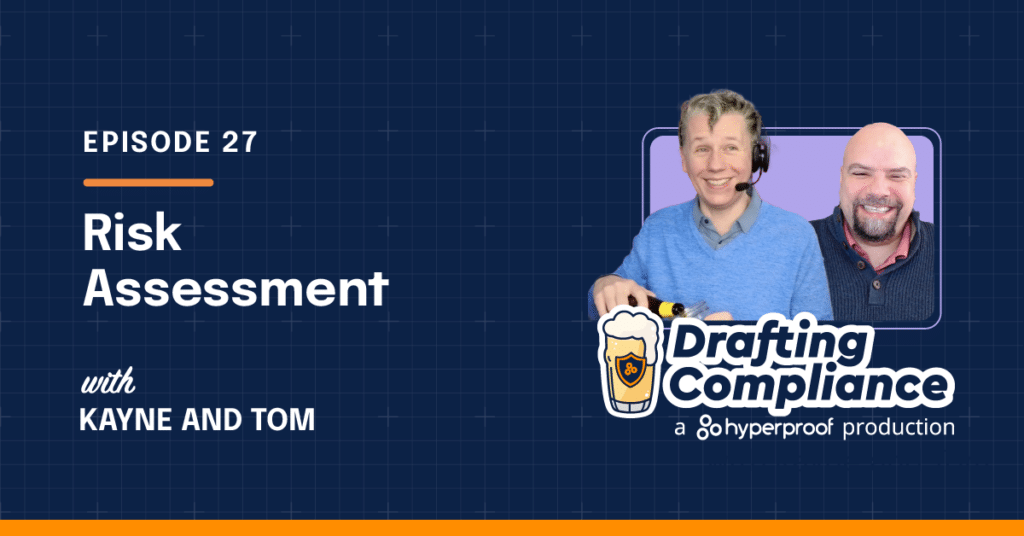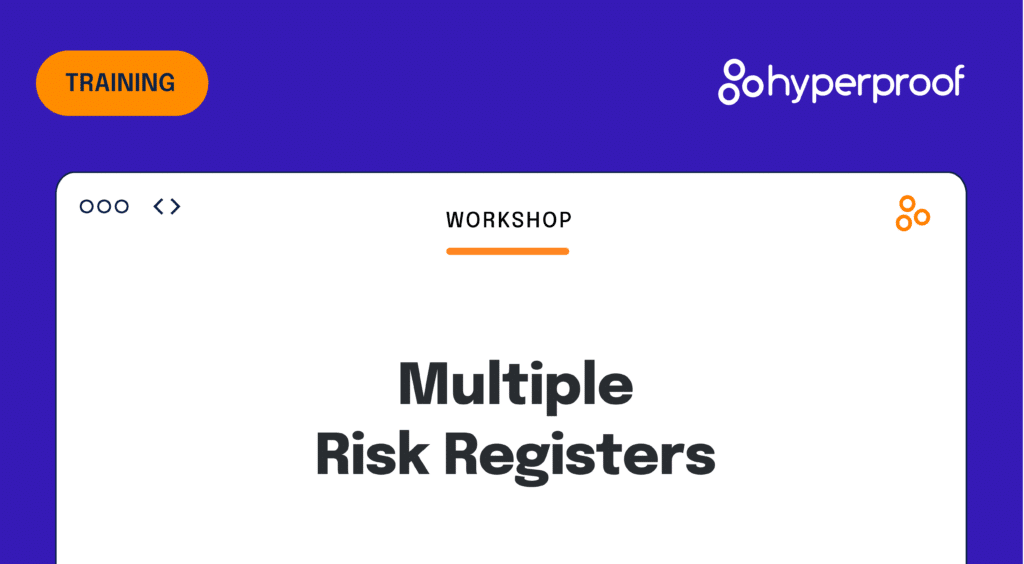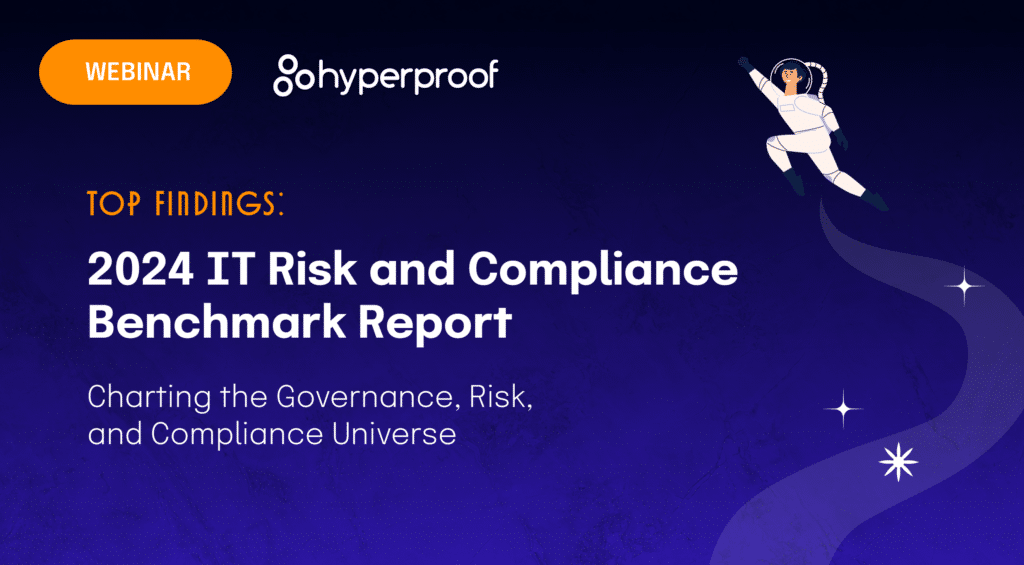Updating Your Risk Assessment Process for the Modern Era of GRC

Mastering the risk assessment process in the dynamic Governance, Risk, and Compliance (GRC) landscape is fundamental for your business’s stability and growth. Starting from scratch or regularly updating your risk register might seem overwhelming, but your investment of time and money protects you from harm. The modern era of GRC beckons a transformative approach, positioning risk and compliance as a business enabler, not simply a cost center.
As experts in GRC risk assessment, we’ve witnessed the seismic shifts in the landscape, notably the current challenges that loom large over compliance and risk teams. The economic downturn has spotlighted the need for teams to address risk with fewer resources, amplifying the urgency to find innovative solutions. Organizations can employ tools to automate aspects of the risk assessment process seamlessly, thereby enhancing the efficiency of risk and compliance functions and transforming them into catalysts for business enablement.
Let’s dive into all the details of the modern risk assessment process — uncovering how and why you should conduct yours, exploring the various types of risks you should consider, and providing comprehensive insights to empower your organization in navigating the intricate landscape of GRC.
What is a risk assessment, and what is the process?

A risk assessment is the systematic process of identifying, analyzing, and evaluating an organization’s potential risk. It involves assessing the likelihood and impact of various threats to determine their significance and prioritize them for appropriate management. In the context of GRC, risk assessment is a crucial element that enables organizations to understand and navigate uncertainties, make informed decisions, and implement measures to mitigate or manage potential adverse events, such as sensitive data breaches. Risk assessment is an ongoing and dynamic process that helps organizations proactively address challenges, ensuring resilience in the face of evolving threats and changes.
The risk assessment process is a strategic journey organizations take to fortify their foundations. The process unfolds systematically, identifying various risks that could impact the organization. These risks encompass a spectrum of possibilities, ranging from financial uncertainties to operational disruptions and regulatory compliance issues. Once identified, each risk undergoes a meticulous analysis, gauging its likelihood and potential impact. This analytical phase serves as a compass, guiding organizations to prioritize risks based on their significance.
The next step is to devise and implement tailored management strategies that help your business take a proactive stance against potential adversities. In the GRC era, this process has become a dynamic loop, continuously evolving to address emerging threats and changes in the business environment. By weaving informed decision-making into the organizational fabric, the risk assessment process becomes a cornerstone, empowering businesses to navigate uncertainties.
Why do you need a risk assessment process?

Initiating the risk assessment process can be daunting, particularly for newer organizations or those with lower maturity levels. The challenge often lies not in the “how” but in overcoming the reluctance to discuss the “why” behind the need for risk assessments. Though potentially uncomfortable, these discussions are essential and should aim to educate employees on the importance of GRC in a blame-free and open manner.
With this in mind, let’s discuss why risk assessments are essential for businesses of all types and sizes.
Justifying costs and resources
Firstly, risk assessments serve as a valuable tool for cost justification, providing a tangible list of vulnerabilities that can be presented to upper-level management. This presentation is crucial in illustrating the need for additional resources and budget allocation to enhance information security processes and tools.
Guiding proactive measures
The risk landscape constantly evolves, necessitating continuous assessments. Regular risk assessments increase productivity by guiding the information security team on where to allocate their time. Instead of reacting to security issues after they occur, GRC and IT professionals can focus on proactively identifying and mitigating risks, preventing incidents from happening in the first place, and opening up more room for strategic thinking.
Fostering collaboration
Risk assessments bridge IT/GRC teams and senior management, facilitating meaningful discussions about evolving risks and necessary security measures. This collaborative effort extends across departments, offering a comprehensive view of the organization’s operations, system usage, and information flow and fostering a unified approach to information security across the entire organization.
Broadening communication
Risk assessments allow IT and compliance teams to communicate the significance of information security throughout the organization, helping each employee comprehend their role in contributing to security and compliance objectives. The process is adaptable, making it applicable to businesses of any size, even those without extensive IT or compliance teams. Employing a powerful platform to streamline and enhance this ongoing process helps your business proactively manage risks and educate your company about their importance.
3 common types of risk assessments

1. Compliance risk assessment
A compliance risk assessment methodically examines an organization’s adherence to regulatory requirements, industry standards, and internal policies. This assessment aims to identify areas where the organization may be at risk of non-compliance and assess the potential impact of such non-compliance. Organizations that conduct compliance risk assessments can proactively tackle regulatory challenges, minimize legal and financial risks, and ensure that their operations align with relevant laws and standards.
2. IT risk assessment
An IT risk assessment focuses on evaluating and managing the potential risks related to an organization’s information technology infrastructure and systems. This includes assessing vulnerabilities in software, hardware, networks, and data management processes. The primary objective is identifying and prioritizing potential threats to the confidentiality, integrity, and availability of IT assets. IT risk assessments help organizations implement adequate security measures, allocate resources efficiently, and safeguard against cyber threats and data breaches.
3. Vendor risk assessment
A vendor risk assessment systematically evaluates the risks of engaging third-party vendors or suppliers. This process involves analyzing various aspects, such as the vendor’s financial stability, security measures, compliance with regulations, and overall reliability. The goal is to protect the organization’s interests when collaborating with external parties and identify and mitigate any potential threats or vulnerabilities the vendor introduces.
Getting Started: Risk assessment framework (RAF) examples and strategies

Embarking on your risk assessment journey requires a strategic approach, and while numerous frameworks are available, it’s crucial to select a framework that aligns with your organization’s needs and objectives and commit to implementing it effectively. Remember, when starting with any framework — even on a small scale — it is better to refine and gradually enhance it through iteration.
Rather than creating a risk management framework from scratch, consider tailoring an appropriate pre-existing one, such as ISO 27001 or NIST CSF, to suit your organization’s unique context. Making informed decisions based on established frameworks provides a solid foundation and ensures your efforts are grounded in recognized methodologies. This approach enhances the credibility of your risk assessment plan and facilitates communication and benchmarking with industry standards.
Here’s a streamlined strategy to initiate your risk assessments.
1. Conduct an internal audit
To comprehend current risk management, start by evaluating existing compliance, finance, and HR controls.
2. Gather employee insights
Use surveys or forums to gain employee perspectives on potential internal concerns.
3. Evaluate critical assets and processes
Pinpoint what’s essential for your business to operate and protect these areas first.
4. Collect historical data
Investigate previous minor incidents to identify patterns that may signal more significant risks.
5. Prioritize your risks
Focus on risks with the highest potential impact based on your gathered data.
By following these steps, you’re laying the groundwork for a robust risk management strategy. Aim for continuous improvement.
4 tips for a successful risk management process

1. Start now
Commencing this journey with an experienced partner is more fruitful than succumbing to decision fatigue and over-analysis. Organizations often face the temptation to delay the risk assessment due to fears of inadequacy or the desire for a perfect plan. However, waiting for the perfect moment can lead to missed opportunities and increased vulnerability. Now is the right time to start; collaborating with experts can make the work much more manageable.
2. Prioritize communication
Engaging in conversations about risk must go beyond procedural discussions to foster a blame-free environment. This approach ensures that the assessment becomes a constructive and beneficial exercise rather than a painful one. It encourages open dialogue, diverse perspectives, and a shared commitment to addressing potential challenges head-on. A centralizing platform for GRC communication further enhances transparency and collaboration, enabling organizations to confidently navigate the initial hurdles of the risk assessment process and set the stage for a more resilient and proactive risk management strategy.
3. Strive for universal risk scaling whenever possible
Define what constitutes a risk and establish a standardized scale for categorizing risks. Although there will inevitably be inconsistencies with large global enterprises, everyone at the top level of the organization should share a common understanding of terms such as low, medium, and high risks. This alignment ensures consistency in risk assessment evaluations, preventing subjective interpretations or varying personal risk tolerance.
4. Determine which stakeholders to involve
Your organization needs to decide how deep the assessment will go and identify the specific groups or individuals to participate. This could involve surveying the entire company or focusing on particular departments, leadership teams, the C-suite, or the board. While involving an infinite number of people might create redundancies, a well-structured approach can streamline the process.
Modernizing your risk assessment process in the era of GRC

In modern GRC, risk and compliance transform from mere cost centers to vital business enablers. Organizations recognize the strategic value of adopting the right tools and tech solutions to streamline and automate various aspects of the risk assessment process. This shift enhances efficiency and empowers risk and compliance functions to actively contribute to business enablement.
As highlighted in our article, What Are Your Current Compliance Operations Costing You? Integrating advanced tools enables organizations to meet compliance requirements with increased efficiency. Moreover, these tools facilitate seamless expansion to support new frameworks, aligning with overarching business objectives and reducing risk exposure. This transformative approach departs from traditional perspectives, positioning risk and compliance as integral drivers of organizational success rather than mere cost centers.
A commitment to documentation and the strategic linkage of controls to identified risks characterizes a modern GRC program. It becomes imperative to meticulously document all aspects of the organization, ensuring that controls are explicitly associated with corresponding risks. This approach safeguards against the impact of employee turnover, providing a comprehensive understanding of the risk landscape even as personnel changes over time.
Take control of your risk management with Hyperproof and safeguard your operations for a secure, compliant, and resilient future.

Hyperproof is a valuable tool in this modernization journey, facilitating the seamless connection of risks to controls. With Hyperproof, organizations gain visibility into redundant practices, identify risks lacking adequate controls, and assess the health of existing rules through automated testing. This streamlines the documentation process and liberates teams from the burden of manual information gathering, allowing them to focus on strategic initiatives. By maintaining a live connection between controls and a dynamic risk register, organizations can proactively address failures and implement remedial actions in real time, breaking free from the conventional practice of waiting months for periodic risk assessments.
For risk committees, Hyperproof’s SaaS platform enables transparent showcasing of accomplishments, demonstrating tangible risk reduction outcomes such as cost savings and insurance benefits, providing a straightforward narrative of the impact achieved.
Hyperproof: Streamlining and integrating risk and compliance workflows

Embarking on the risk assessment journey presents a crucial decision point for organizations: should they go it alone, tap into the insights of internal experts, or seek guidance from external consultants? Each option brings unique challenges, from the potential limitations of a solo venture to the cost concerns associated with hiring external help.
Hesitating to trust external perspectives can complicate decision-making, resulting in significant time and financial costs. Hyperproof offers a transformative solution by providing a seamless platform for continuous organizational risk management. With Hyperproof, you streamline your workflow, gain insights into unnecessary practices, and identify risks that lack corresponding controls.
Experience the future of risk and compliance management, where informed decision-making is simplified, and the transformative capabilities of your risk assessment process are fully realized.
See Hyperproof in Action
Related Resources
Ready to see
Hyperproof in action?












